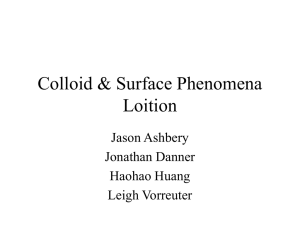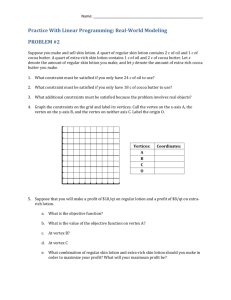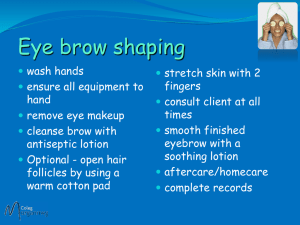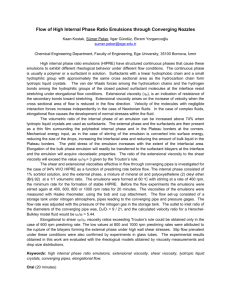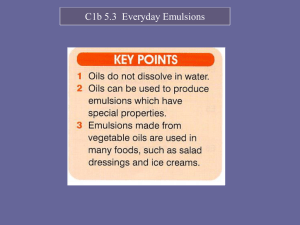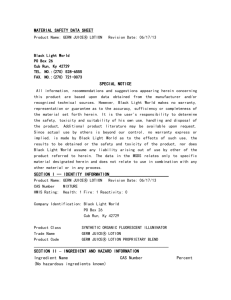Moisturizing Lotion - School of Engineering and Applied Sciences
advertisement
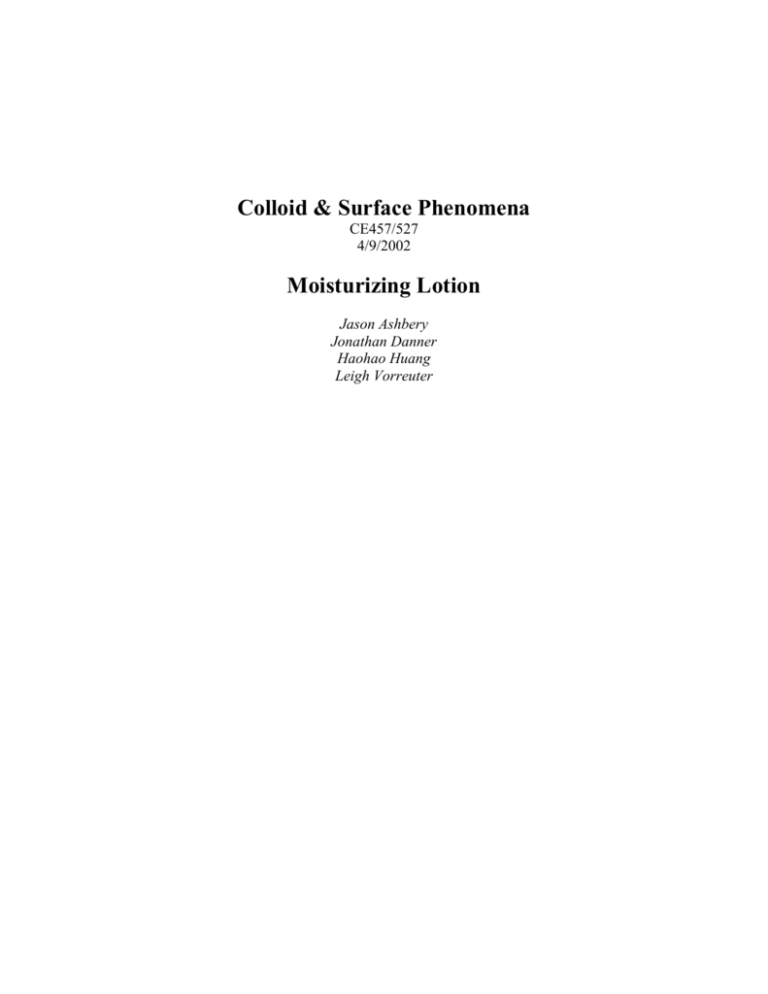
Colloid & Surface Phenomena CE457/527 4/9/2002 Moisturizing Lotion Jason Ashbery Jonathan Danner Haohao Huang Leigh Vorreuter I. Introduction The general title cosmetics are applicable to a wide array of products. Some cosmetics such as blush or eye shadow are used to enhance the color of the person’s eyes or cheeks. Other cosmetics are used to protect the skin, for an example to delay the aging process. Some examples are lotion, creams, and sunscreen. Each one is different and carries different responsibilities. Lotion can hold many different responsibilities. Lotion is considered a cosmetic product. It should improve the skin and have many useful purposes. Some lotions contain sunscreen that contains UV protecting agents that may reflect the harmful affects of the sun. Other lotions contain alpha hydroxides that improve the appearance of the skin. These beneficial attributes need help to deliver the wanted components to the skin and cause adhesion to the skin and also penetrate the skin. There is a huge assortment of lotions to assist in customer’s needs. Some people prefer scented lotions compared to unscented. Others like quick absorbing lotion. Lotions sometimes need to be very sensitive to a person’s skin. A person may need lotion to heal dry skin while another might use it to prevent dry skin. Some women may feel like their skin has aged and some “age defining” lotion can help the skins appearance. There are many different varieties of lotions for instance; for dry skin, for extra dry skin, and for sensitive skin. Some contain sunscreen and others have desired fragrances. They are many different manufacturers of moisturizing lotion. The manufacturers market their products towards age and gender. A young girl would be more likely to buy from Bath & Body Works because they have lotions that are scented and their labeling is colorful and attractive. Men on the other hand prefer non-scented lotions. Keri and Curel make non-scented lotions. Other manufacturers such as Bristol-Meyers Squibb lean more towards the pharmaceutical side of lotions. The manufacturers have product specifications related to customer needs. These specifications are very important towards the characteristic of the lotion and are usually 2 over looked by the customer. The lotions need to have an appropriate shelf life and it needs to have a good physical and chemical stability as well as cosmetic appeal. This is essential for any lotion because if the lotion has a short half-life the mixture will separate and not be able to be used. It also needs to reach its goal of moisturizing which means the active ingredients need to reach the desired target. The lotion has to be non-irritating to the skin and the pH needs to be a consideration. Lotions also must be fast absorbing and non-greasy. The duration that the lotion stays on the skin is important. It also needs to be long lasting. The lotion needs to go on smoothly and evenly and removed from the skin when it is appropriate. The product design considerations are an essential part of the manufacturing process and the formulation of the moisturizing lotion. A manufacturer must identify their consumers needs are establish the appropriate product specifications in order to be successful. 3 II. Components and Composition There are many different brands of moisturizing lotion on the market today. Most manufacturers also make several different formulations of the same brand. The result is a relatively large number of formulations for the consumer to choose from. It is important to realize however, that most of the lotions being sold share several of the same components. Two major differences between competing brands are noted in this section. Component listings may vary significantly from product to product based on the color and scent of the lotion. These various fragrances and dyes may seem to monopolize the ingredient list, but they are only present in extremely small percentages. The second difference is definitely not as obvious as the first. Lotion manufacturers use various surfactants to enhance product performance. Common ingredients names for these surfactants include the following: Laureth-23, Ceteareth-20, Quarternium-15, and Dimethyl Distearyl Ammonium Chloride to mention just a few. Manufacturers may also include alpha-hydroxy acids such as glycolic and lactic acid.12 The following table was created using the ingredient listings located on the backside of the bottles. It is presented in this format to further illustrate how many brands share common components. For simplicity, ingredients listed on only one of the five lotions do not appear in the table. Note that surfactants vary from product to product and may not be included in this list. 4 Table 1. Common Components Present in Different Brands of Moisturizing Lotion* Suave Bath & Body Bristol The Andrew Works Meyers Jergens Co. Body Benefits Water X X X X X Glycerin X X X X X (Tetra, Tri, or Di-) sodium EDTA X X X Dimethicone X X X Carbomer X X X X X Tocopheryl Acetate (Vitamin E) Aloe gel X X Petrolatum X X X Glyceryl Stearate X X X Sodium Hydroxide Methylparaben X DM DM Hydantoin X Magnesium Aluminum Silicate X Propylparaben X Mineral Oil X X X X X X X X X X X Benzyl Alcohol X X X X X Isopropyl palmitate X Cetearyl Alcohol X X X X Ceteareth-20 X X Cetyl Alcohol X * Components present in only 1 of the 5 lotions are not listed here. The primary ingredient in most moisturizing lotions is de-ionized water. It can be expected that water comprises anywhere between 60 and 95 weight % of the lotion. Following is a graphical display of the composition of a particular formulation of moisturizing lotion taken from U.S. Patent # 6,017,548 assigned to The Andrew Jergens Company.12 5 Table 2. Approximate Composition of a Lotion Patented by The Andrew Jergens Company (U.S. Patent# 6,017,548) Chart # Components Approx. % Weight 1 Water 93.2 2 Glycerin 2.4 3 Dimethyl Distearyl Ammonium Chloride 4 Petrolatum 0.8 5 Lactic Acid 0.6 6 Isopropyl palmitate 0.6 7 Cetyl Alcohol 0.5 8 Glycolic Acid 0.4 9 Dimethicone 0.3 10 Ammonium Hydroxide 0.2 11 Methylparaben 0.02 12 Propylparaben 0.008 1 Graph 1. Approximate Percent Weights 1 2 3 4 5 6 7 8 9 10 11 12 6 III. Colloids and Surface Interactions Throughout the diverse moisturizing lotions that are sold today there exist common ingredients that perform key universal functions to moisturizing lotions. The most abundant of these ingredients is water, whether it is purified or deionized. Since moisturizing lotion is an oil-in-water emulsion, water is the continuous phase and functions as the diluent. Glycerin (C3H8O3) serves as the humectant, which adds moisture to the stratum corneum, which is the skin, and helps to soften the skin Silicone fluids are also utilized in lotions as an emollient or smoothing aid. improve the lubricity of the moisturizing lotion when it is applied to the skin 12 . They 12 . An example of a commonly used silicone fluid is Dimethicone (C2H6OSi). Petrolatum and/or mineral oil are added to the emulsion to serve as an occlusive emollient. These hydrocarbons form a hydrophobic film on the surface of the skin, which prevents water loss from the skin to the environment. It traps the moisture in the skin. Disodium EDTA functions as the chelating agent 16 , and carbomer, a carboxyvinyl polymer, acts as a thickening and emulsifying agent. A key difference among various lotions is the type of surfactant/emulsifier used. Despite the use of different emulsifiers the basic the function of the amphiphile remains the same, which is to stabilize the oil-in-water emulsion by acting at the oil-water interface. One example of the surfactant used in Keri Fragrance Free Lotion is Quaternium-15, which is a cationic emulsifier. In addition to the universal ingredients, many other molecules become a part of lotion. These might include fatty alcohols such as cetyl alcohol, which combined with the surfactant aid in stabilizing the emulsion 5. Further examples include nutrients such as tocopheryl acetate (Vitamin E), preservatives, and fragrances. Some of these components, for Keri Fragrance Free Lotion, along with their basic functions are shown below in Table 3.21 7 Table 321 KERI FRAGRANCE FREE LOTION Component Basic Function Water Glycerin Dimethicone * Petrolatum * Disodium EDTA Carbomer * Quaternium-15 * Cetyl Alcohol * Tocopheryl Acetate (Vitamin E) * Steareth-2 * Aloe gel Benzyl Alcohol Laureth-23 * Magnesium Aluminum Silicate Sodium Hydroxide * = "colloidal" sized molecules diluent humectant emollient, smoothing aid occlusive emollient chelating agent thickening agent, emulsifying agent cationic surfactant, cationic emulsifier emollient, emulsion modifier, coupling agent nutrient emulsifier, wetting agent nutrient antimicrobial emulsifier, wetting agent thickening agent alkalizer, pH adjuster A. Liquid/ Liquid Emulsion Moisturizing lotion is a liquid-liquid emulsion. An emulsion is formed when a mixture of two immiscible liquids are separated by a surfactant molecule, which lines the interface of the liquids. The surfactants are amphiphilic molecules composed of a hydrophilic polar headgroup and a “hydrophobic” nonpolar tail. When placed into an oilwater solution, the amphiphiles spontaneously aggregate at the oil-water interface to minimize unfavorable interactions. They do so by orienting themselves in such a manner that their headgroups point into water while their nonpolar tails point into the oil. In a microemulsion of oil-in-water, O/W, the surfactants form droplets of oil in water. Likewise a microemulsion of water droplets in oil, W/O, can also be attained, where the surfactant headgroups point into the water and the nonpolar tails face outward into the oil. Depictions of an O/W (a) and W/O (b) microemulsion are shown below in figure 1. below 1. 8 Figure 1 Moisturizing lotion is an oil-in-water, O/W, emulsion. However, the process of making lotion begins with a W/O emulsion. During the mixing procedure, a phase inversion occurs changing W/O to O/W. There are at least three possible factors that can be altered to achieve this phase inversion. They are: (1) temperature, (2) surfactant composition, and (3) water concentration. The temperature of the emulsion can lead to a phase inversion if temperature sensitive emulsifiers, such as ethoxylate emulsifiers, are used as surfactants 9. Ethoxylate emulsifiers become less hydrophilic when heated. Therefore, emulsions that use them change achieve a reversible phase inversion from O/W to W/O at a well-defined temperature, called the phase inversion temperature (PIT). “Cosmetics O/W emulsions with improved stability and small droplet size can be manufactured by producing a W/O emulsion at high temperature and cooling through a phase inversion” 9. This technique of varying the emulsion temperature only leads to a phase inversion if ethoxylated 9 surfactants are used. This is because other types of surfactants do not show a significant sensitivity to temperature change 9. The surfactant composition in the emulsion can also be altered in order to achieve a phase inverse. For example, consider a W/O emulsion that is generated using a hydrophobic emulsifier and to which is added an aqueous solution of hydrophilic surfactant. At low hydrophilic surfactant concentration the system remains as a W/O emulsion. However, as the hydrophilic concentration increases, the system will eventually undergo a phase inversion from a W/O to an O/W emulsion 9. Finally, a third variable that can lead to a phase inversion is the water concentration in the emulsion. Starting with a W/O emulsion, if a sufficient amount of water is added to the system, a catastrophic phase inversion will occur resulting in an O/W emulsion 9. This is the technique by which the Andrew Jergens Company prepares moisturizing lotion: The oil-in-water emulsions of this invention are prepared by first forming an aqueous mixture of the water-insoluble component and the humectant. The water-insoluble components include the cationic emulsifier, the petrolatum or mineral oil component, the fatty alcohol component, the fatty ester emollient, and the silicone component. The components are preferably added to water in the following sequence: humectant, petrolatum/mineral oil, fatty ester, silicone oil, fatty alcohol. After these components are thoroughly mixed, the cationic emulsifier is added to the aqueous moisture at a temperature of about 80 to 95 degree C. under agitation to form a water-in-oil emulsion. The input of the mixing energy will be high and will be maintained for a time sufficient to form a water-in-oil emulsion having a smooth appearance (indicating the presence of relatively small micelles in the emulsion). Water is then directly injected into the emulsion to cool it to a temperature of about 45 to about 60 degree C. The temperature is critical. Unstable emulsions result if the temperature drops below about 45 degree C. Higher temperatures promote unacceptable water loss through evaporation. During this quench step the emulsion, initially water-in-oil, inverts to form an oil-in-water emulsion.12 10 B. The Effect of Amphiphiles on Delivery to the Skin One type of surfactant used in moisturizing lotions is the cationic surfactant; positively charged molecules in solution. The behavior of ionic micelles can be explained by ‘hydrophobic’ tail and headgroup characteristics. As the temperature of the emulsion increases, the critical surfactant concentration for micelle formation (CMC) increases and the number of amphiphile molecules per micelle (No) decreases. The increase in temperature leads to a greater repulsion between headgroups, resulting in a higher Gel, a higher Gmic, and an increase in CMC. 1 Gel is the free energy associated with purely electrostatic interactions arising from headgroup repulsions. Gmic is the free energy of micelle formation. Ultimately, the increase in temperature decreases the stability of the emulsion by decreasing the stability of the micelles. Furthermore, the addition of salt lowers the CMC while increasing the No. Adding salt has the opposite effect on ionic micelles than raising the temperature. 1 The effect of temperature on ionic micelles may also effect the mechanism of moisturizing lotion on the skin. While the exact mechanism is not entirely understood, it is believed that the temperature change that occurs when the lotion is applied to the skin induces a phase change; causing the humectant (glycerin) to move from the micellular interface to the external surface of the emulsion. The humectant is then able to transfer to the stratum corneum in order to moisturize the skin12. Perhaps the higher temperature of the skin destabilizes the micellular structure, releasing the humectant inside. Cationic surfactants are not the only type of emulsifiers that are used to prepare moisturizing lotion. For example Noveon has formulated a moisturizing lotion with Pemulen polymeric emulsifiers. Pemulen emulsifiers have the ability to form longterm stable O/W emulsions that have a triggered release mechanism. “Pemulen emulsifiers instantly deswell upon contact with the electrical charge on the skin to release the oil phase and provide immediate coverage, eliminating the lengthy lag time seen using traditional surfactant systems.”16 In traditional surfactant systems liquid crystals 11 made up of oil, water, and surfactant are formed and are deposited on the stratum corneum. These liquid crystals temporarily prohibit the oil phase from being released to the skin so that it cannot form a desired occlusive film. The crystals can last for up to 90 minutes before they are degraded due to the evaporation of water from the liquid crystals to the environment. An illustration is shown below, Figure 2, comparing the application of traditional surfactant systems to emulsions formulated with Pemulen polymeric emulsifiers. 16 Figure 2 Unlike cationic surfactants, Pemulen appears to be electrically sensitive rather than temperature sensitive. Cationic surfactants and Pemulen are examples of how the use of different surfactants directly influences the mechanism by which moisturizing lotion aids the skin. 12 IV. Product Attributes The colloids, polymers, and surfactants enhance and affect the product specifications. Each ingredient serves at least one purpose. Many of the ingredients have multiple purposes. For the four chosen moisturizing lotions one can see the similar components. Water is the main component of lotion and its main purpose to serve as a diluent. Dimethicone, Glycerine, EDTA, and Carbomer serve many different basic functions for example as emollients, humectants, chelating agents, and thickening agents. In Table 3 Keri fragrance free lotion shows its main functions of its ingredients. Some examples of colloids and polymers that enhance the affect the product specification are described. Dimethicone is a silicone fluid mixture that enhances the durability, gives a nice soft feeling and is also an anti-whitening agent. It gives the skin a pleasant shine. Laureth-23 is a non-ionic emulsion that is often used as a conditioning agent in lotions. It gives skin luxurious feeling when applied. Fatty acids such as Benzyl or cetearyl alcohol thicken and stabilize the lotion. 5 The functionality of primary ingredients in relation to customer needs is one of the most important characteristics of lotion. The lotion’s shelf life, absorption properties, consistency, and fragrance are altered through different colloids, polymers, and surfactants. Also sunscreens, alpha hydroxide, slow release of fragrances, and prolonged hydration properties are achieved by different colloidal particulate systems.8 The shelf life of moisturizing lotion is extremely important. A company can estimate the amount of time it takes for a bottle to be bought. Once the bottle is bought it could take up to a year to finish and it all depending on the amount of lotion in the bottle. Bigger bottles of lotion are much more economically efficient, but no one would buy the lotion if it were going to go “bad”. This is why the shelf life is such a crucial part of lotion. Adjusting the hyrdophile and lipophile balance of the emulsifier is a very important aspect for achieving emulsion stability. 12 Emulsions prepared with hydrophobically modified water-soluble polymers are stable for years. The lotion’s dermatological emulsions are thermodynamically unstable due to its positive interfacial energy. When 13 the emulsion tries to reach its thermodynamic equilibrium it causes the emulsion to break up back into its component phase. In order for the product to be able sustain it shelf life qualities, the formula must attempt to delay the separation process. The delay can be accomplished by adding specific mixed emulsions compiled of ionic or non-ionic surfactants combined with fatty amphiphiles (Table 4). 5 Table 4 Fatty amphiphiles Cetostearyl alcohol Cetyl alcohol Stearyl alcohol Glyceryl monostearate Stearic acid Phosphatidylcholine Surfactants Sodium lauryl sulphate Cetrimide Cetomacrogol 1000 PEG 1000 monostearate Triethanolamine stearate Sodium stearate Incorporating previously blended emulsifying wax into the formulation can also prevent the separation of the emulsion. Some wax and its components are represented in Table 5. Table 5 Emulsifying wax Emulsifying wax BP Emulsifying wax USNF Cationic emulsifying was BPC Glyceryl monostearate S.E. Cetomacrogol emulsifying wax BPC Polawax Component Cetostearyl alcohol, sodium lauryl sulphate Cetyl alcohol, polysorbate Cetostearyl alcohol, cetrimide Glyceryl monostearate, sodium stearate Cetostearyl alcohol, cetomacrogol 1000 Cetyl alcohol, non-ionic surfactant The gel network theory of emulsion stability is why both emulsifiers and mixed emulsifying wax give their desired results. “The theory relates the structure and properties of liquid and semisolid emulsions to the swelling properties of a lamellar, crystalline gel network phase formed when the mixed emulsionfier, in excess of that required to stabilize oil droplets, interacts with continuous phase water.” 5 These emulsifiers must stabilize the oil droplets at the manufacturing point by the formation of an interfacial film. This is simply controlling the rheolgical properties of the formulation. 14 The lotion’s consistency is due to swelling properties and concentration of the αcrystalline gel phase. The gel phase is a lamellar structure of alternating bilayers of emulsifying wax separated by layers of water. When the α-crystalline form is in the presence of very small quantities of ionic surfactant and a fatty alcohol is dispersed in the water the amount of swelling increases which leads to the swelling of the α-crystalline gel phase. The water that is in between the bilayers of the gel phase is essentially bound water and this increases the volume ratio of the dispersed phase to the free continuous phase water. This causes the system to thicken. 5 The evaporation and absorption of lotion is a very complex system. When lotion is applied to skin thinly, emulsion destabilization often occurs during the use. When a dermatological emulsion is rubbed onto the skin water evaporates and the oil droplets coalesce.5 Coalesence occurs when the interaction energy between substrates and adatoms is small, clusters can detach them selves from any given location on the surface and diffuse as entities over the surface. The clusters behave more like liquid droplets than solid crystallites when they coalesce. They can even liquefy, but re-solidify immediately after to assume the prior configuration.1 After the application of the lotion the composition will change as water and other volatile solvents evaporate. The film stays on the skin to protect it and the drug is absorbed into skin. 5 The viscosity of moisturizing lotion is another very important attribute. Emulsion size plays a big role with the lotions viscous properties. An experiment was completed where the shear stress dependence of the apparent viscosity of monodisperse emulsions with different droplet size and concentrations was measured. The viscosity increased with the increasing droplet concentrating. At the same shear stress and droplet concentration the viscosity of concentrated emulsions containing smaller droplets was significantly greater than emulsions containing larger droplets. This suggests that electrostatic repulsion plays an important role in determining the rheology of concentrated emulsions. The droplets become closely packed causing the emulsions to be come rigid at lower concentrations for smaller droplets because of their effective volume fraction is greater.10 This explains why low emulsifier concentrations are good for structured lotion.5 Viscosity is very 15 important when it comes to differentiating between creams and lotions. Lotions are used on large body parts like legs and arms. Consumers like their lotion to glide easily. Therefore a less viscous moisturizer would be ideal. Also absorption capacity on the skin increases with decreasing viscosity.2 Fragrances in cosmetics especially lotion are very important. People base their decision to buy a product by the way it smells and how long the duration of the fragrance last. Fragrances for skin care products are applied in colloidal systems like emulsions. The lipid part of the stratum corneum is organized in lamellar structures. The lamellar liquid crystals in lotions contain the fragrance molecules. The similarity of the configuration of the crystals in lotion compared to the stratum corneum is why it easy for the fragrance to be absorbed into the skin. The location of the interlayer spacings and the geometrical characteristics play a big role on where the location of the fragrance is. Also the biomembranes are related to the delay of the disappearance of the fragrances. A main reason consumers buy cosmetic lotions is to help their appearance of their skin. Liposomes have positive effects on the appearance of the skin. They improve cutaneous hydration and skin structure. They also decrease the depths of wrinkles and decrease eye puffiness. Liposomes are spherical vesicles that have an aqueous cavity at their center. They are used to carry water-soluble molecules and hydrophobic molecules. These have the ability to be incorporated within the bilayer membrane. Liposomes have been evaluated as delivery systems for drugs, vitamins and cosmetic materials. Liposomes can be custom designed for almost any need by varying the lipid content, size, surface charge and method of preparation. The liposomes have a structure similar to the cutaneous cells therefore they can interact with each other and they can supply phospholipids to the skin. The phospholipids are what the skin needs to improve it.8 Particulate systems are very small particles that range from micrometers to millimeter. These particles deliver essential active ingredients such as amino acids, plant extracts, minerals, vitamins, antioxidants, and UV protectants. These particles function is to deliver the ingredients to the upper layer of the skin. They also prolong the time during 16 which the ingredient remains on the skin. This is important with sunscreens because one doesn’t want to have to reapply it every hour. It is also incorporated with the time release of fragrances and prolongs the hydration properties. 8 17 V. The effluence of structure of moisturizing lotion (texture parameter) on its use properties, and control of its physical properties The texture parameter (its physical characterizing parameter) is related to the properties of moisturizing lotion and consumer’s acceptance. Table 1 provides the relations between some texture parameters and popular nomenclature. [17] Table 6. Texture profile [17] Primary Secondary parameter parameter Mechanical hardness characteristics Cohesiveness viscosity elasticity adhesiveness Geometrical Particle size and shape characteristics Particle shape and orientation Other Moisture characteristics content Fat content Popular terms Soft→firm→hard Crumbly→crunchy→brittle Thin→viscous Plastic→elastic Sticky→tacky→gooey Gritty, grainy, coarse, etc. Fibrous, cellular, crystalline, etc. Dry→moist→wet→watery Oiliness greasiness oily greasy From the table above, we can believe that the consumer’s sensory description of the lotion has close relation with the texture structure and physical parameters. The skin care product evaluation is also related with the texture profile parameter, shown in Table 2. According to the introduction above, the physical characteristics, especially rheological behavior of lotion is very important to its properties. We should control the rheological behavior of lotion. There are some important factors will affect the rheological behavior of lotion. 18 Table 7. texture profile parameter used in the skin care product evaluation [17] Stage of evaluation PICK-UP, product removed from container, product poured or squeezed from bottle onto fingertips, or product lifted from jar with forefinger RUB-OUT (application), spread of product over and into skin with fingertips using gentle circular motion at a rate of two rub per second for a specified period of time, depending on the product. AFTER-FEEL (and appearance), evaluation of skin surface with fingertips, visually and kinesthetically immediately after product application and possible at varying intervals thereafter. Skin care product attribute and definite THICKNESS-perceived denseness of product. Evaluated as force required to squeeze between thumb and forefinger. Rated as thinmedium-thick. Or: CONSISTENCY-perceived structure of product. Evaluated as resistance to deformation and difficulty of lifting from container. Rated as light-medium heavy. SPREADABILITY-ease of moving product from point of application over rest of face. Evaluated as resistance to pressure. Rated or described as: ‘slips’-very easy to spread ‘glides’-moderated easy ‘drag’-difficult to spread Texture profile parameter Viscosity for lotions Viscosity, cohesiveness, springiness, gumminess, adhesiveness Other characteristics – (oil and water content of product) ABSORBENCY-Rate at which product is perceived to be absorbed into skin. Evaluated by noting changes in character of product and in amount of product remaining (tactile and visual) and by changes in skin surface. Rated slowmoderate-fast. AFTER-FEEL – Type and intensity of product residue left on skin; changes in skin feel/ Product residue is described by type, i.e. film(oily or greasy), coating(waxy or dry), flaky or powdery particles; the amount of such residue is identified as slightmoderate-large. Skin feel is described as dry (taut, pulled, tight); moist (supple, pliant), oily(dirty, clogged). Other sensations are also noted and identified where applicable, i.e. clean, stimulated, irritated, etc. Other characteristics-(oil and water content) Geometrical characteristics-(gritty, powdery, etc.) 19 1. Factors influencing the lotion physical parameter [18] (1). THE EMULSIFIER[18] The emulsifier frequently is the most important role in the emulsion in producing the characteristic flow properties. In dilute emulsions this is more evident because when the concentration of emulsifier is varied, the effects of change in particle size and particle size distribution of the disperse phase on the viscosity of the emulsion are not as big as the change in the viscosity of the continuous phase brought about by the emulsifier. Mixed emulsifiers can provide desirable flow properties (used to thicken lotion, see also table 2) and to reduce cream of lotion. (a) Hydrophilic polymer emulsifier: the study has gotten the apparent pseudoplastic viscosity for these hydrocolloids from plot of log (shear rate) vs. log(shear stress). (b) Mixed emulsifier: In O/W emulsions the viscosity can be affected by type and amount of interaction between a lipophilic and hydrophilic emulsifier placed in the oil phase or aqueous phase. In addition, supplementary use of fatty acids or alcohols in the oil phase can modify the rheological parameters of emulsion. The cetyl alcohol emulsion was mobile after 20 days and exhibited only slight creaming. Particle size of the emulsions were similar and the theological stabilities showed no relation with variations in particle size distribution but there is a relation with the stability of the viscoelastic network in the aqueous phase at 25º The chain length of the alcohol can affect the mobility of lotion. After preparing immediately, the tetradecanol (C14) and hexadecanol (C16) emulsion became semisolid and of similar consistency. The octadecanol (C18) stabilized emulsion was extremely mobile, but the cetosteayl alcohol emulsion showed properties of all three emulsions containing the pure alcohols. The effect of concentration of emulsifier cannot explain emulsion behavior of lotion without taking into account secondary effects such as the particle size and particle size 20 distribution, which also exert a pronounced influence on the flow properties of lotion. Studies have shown that the viscosities of concentrated emulsion increase to a greater extent than the viscosities of comparable dilute emulsions when the concentration of the emulsifier is increase. 19 (2) THE DISPERSE PHASE 18 There are many parameters related to the disperse phase or internal phase that exert rheological changes in emulsions, including: nature of the oil; viscosity of the oil; particle size; particle size distribution; and particle shape. Particle size and particle size distribution also depend on the emulsifier concentration. The nature of the oil in O/W emulsion exerts its effect on the emulsion via its interaction with the emulsifier. The viscosity of the aqueous medium and the particle size distribution are related to differences in the state of aggregation of the globules. The mean particle size and particle size distribution can exert profound effects on the rheological parameters of an emulsion. The viscosity of dilute O/W emulsions are influenced by mean particle size variation of 3 to0.7 microns, but in concentrated emulsions the product of relative viscosity and mean particle size did not change if the distribution of particle size about the mean value was not very wide. (3) THE CONTINUOUS PHASE The rheological behavior of a lotion is most often determined by the rheology of the continuous phase. The rheological behavior of the continuous phase of O/W emulsions is frequently controlled by the use of hydrocolloids, which have been already been discussed. The rheological behavior properties of the emulsion, in turn, are dependent on the stability of the hydrocolloidal system. (4) PHASE VOLUME RATIO The rheological patterns of dilute emulsions are often markedly different than those for concentrated emulsions. Therefore, it is useful to have information concerning the 21 viscosity dependence on the phase volume ratio in both areas. Generally, it has been found that the rheological parameters of an emulsion increase with increasing the phase volume ratio. It is expected that the limit of φ before inversion occurs will vary depending on the characteristics of the system and, in particular, the nature of the emulsifying agent and its solubility in the continuous phase of the emulsion. 2. The effects on the behavior of lotion during lotion processing 20 During the processing, we should control the effect in order to get ideal end properties of lotion. (For processing detail, see also part II) (1) Mixing Mixing is a basic step to the compounding and processing of lotion in the cosmetic industry. Mixing is necessary to blend a water phase and oil phase into an emulsion, but consider the potential effect of the degree of mixing on the product viscosity. First of all, a minimum of energy must be used to evenly mix the two phases and other additives. A high amount of mixing energy, however, can decrease the particle size of the dispersed phase and hence affecting the emulsion viscosity. The timing of this mixing energy can also be important, as the product is finished off and cooled to filling temperature. In the case of a lotion, which is usually cooled to room temperature, viscosity can increase tremendously when the product is cooled. If the mixing energy is kept constant during the cooling cycle, it begins to have more of an effect as the viscosity increases. This means that a short period of mixing at 90F can have a greater effect on viscosity than a long period at 150F. If the product is shear-thinning (pseudoplastic or thixotropic), the viscosity reduction is not completely reversible. The mixer in the plant should be suitable to the mixing requirements of various lotions. Not only can the mixer affect the product viscosity, but the product viscosity can also affect the degree of mixing. If a propeller is utilized to mix a viscous product that is shear-thinning, it will cut a hole in the center and leave the bulk of the product unmixed. If a product happens to be shear-thickening, it could gradually build up in viscosity to the point where the mixer motor is overloaded. 22 In case of heat transfer, viscous lotions are usually handled with a contrarotating agitator. Mixing is so basic to the formation of the lotion and can have such an important effect on product rheology that the smart formulator will learn to work with it in achieving the desired end properties instead of fighting against it in a dogmatic scaleup from benchtop to plant. Cosmetic lotion may be shear sensitive to some degree and mixing can be used as a tool in achieving the desired product viscosity by properly manipulating the mixing variables. (2) Heating and cooling Heating is generally less of a problem in cosmetic processing because the product or phase is usually fluid at elevated temperatures (viscosity being inversely proportional to temperature for emulsions commonly encountered in the cosmetic industry). The rate of heating is not usually considered an important parameter, assuming that the desired end point is not overshot. Cooling is more commonly a problem with cosmetic emulsion because it generally increases product viscosity greatly. In summary, a lotion is usually heated after it has been formed to reduce its viscosity for filling. Cooling has a more important relationship to final product viscosity because of its effect on crystallite size and dispersion, and because of the interrelationship of work input and product viscosity. (3) Shearing Many lotions are shear-thining. In a typical operation, a finished lotion is cooled to room temperature in a compounding vessel, and then pumped through a filter to a storage tank where it is held for filling. The viscosity of lotion will have been reduced by this step. Then the product may be pumped to the filling line. The product usually has a chance to build a network of bonds. A portion of these bonds, if broken, are sometimes permanently destroyed. 23 (4) Homogenizing Homogenization, or the reduction of particles to a small and uniform size and their even distribution in a medium, is related to shearing in that frequently used to create the particle breakdown. The cosmetic industry usually resorts to homogenization for dispersing solids and insoluble liquids in a liquid phase and reducing the dispersed particles to a minimum size. The reasons for doing this are numerous and include the desire to increase stability by minimizing globule size and hence decrease the chances of coalescence, to reduce particle size of the disperse phase so as to inhibit settling, and to increase viscosity by forming a finer emulsion. If while the emulsion is hot and both phases still liquid, homogenization will tend to reduce the disperse phase to a minimum size distribution which will impart certain properties (such as increased stability) to the final product when it is cooled down and packaged. If the product is homogenized after some cooling has taken place and viscosity has already started to build, however, the viscosity of the finished product may be permanently reduced. Timing and process step must be considered in developing a process to make a product with the desired end properties. 24 VI. Final Product Considerations a. Manufacturing Process The objective of the manufacturing process is to disperse one liquid within another in an extremely fine form to make certain that separation due to settling either does not occur or takes place very slowly. The process does not normally involve any extraction or chemical reaction. 4 Shear rate plays a major role in liquid-liquid emulsion formation. Another parameter which influences emulsion formation is whether there are sufficient stabilizers present to maintain the smallest droplet size produced for long periods of time. Blend time and the standard deviation of circulation time also influence emulsion formation. These are only a few of the many variables that make it difficult to specify a mixing process based on a desired droplet size. However, if data are available for a particular mixing system then appropriate correlations can be used to try and predict droplet size formation based on different variables. 4 An example of a typical manufacturing process is as follows12: 25 b. Federal Rules and Regulations Current Good Manufacturing Practices are written and enforced by the Food and Drug Administration. The primary objective of these guidelines is to ensure that manufacturers provide consumers with safe and effective products. More specifically, Parts 210 and 211 apply to the manufacturing, processing, packaging, and holding of drugs and finished pharmaceutical products. Moisturizing lotion is not a typical pharmaceutical pill or capsule, however it is applied directly to human skin is therefore subject to the same manufacturing criteria. Part 211 includes a description of the responsibilities of a quality control unit. The quality control unit is responsible for the chemical analysis of all raw materials, intermediate, and finished products. In the case of raw materials, vendor Certificates of Analysis (COA) may be used in place of chemical analysis. The COA may me used only after the quality control laboratory has certified the vender.3 responsible for microbial testing of finished products. Quality control is In addition to this, product stability tests are mandated and normally performed by the quality control unit. Product stability tests are used to identify trends that essentially determine the testing limits for finished products. Final product testing for moisturizing lotion typically consists of but is not limited to the following: Physical Description (Texture, Color, Odor), Specific Gravity, Viscosity, and pH. Any individual batch of product should not look, smell, or feel different from what the consumer would consider normal. The specific gravity of the lotion should be relatively close to unity. Viscosity may vary significantly from brand to brand but it should be such that it does not inhibit delivery from the package or bottle. The pH of the final product is normally close to the skins natural pH of 6.16 Raw material testing is more extensive and beyond the scope of this project. 26 Current Good Manufacturing Practices, Part 211, also indicates that all personal need to be adequately trained or experienced to perform responsibilities delegated unto them. This training should be properly documented. Buildings and facilities are to be designed and maintained with cleanliness in mind. Proper lighting, ventilation, and plumbing are considered necessities. Equipment should be properly cleaned and maintained. Components used in product formulation are to be stored in a manner that prevents cross contamination and material degradation. Containers need to be adequately labeled and each step of the manufacturing process should be documented in a batch record. Batch records should be kept throughout the product’s shelf life. Part 210 provides the manufacturer with an overview and some definitions used in Part 211. c. Marketing Considerations Women comprise the majority of the consumer target group for the sale of moisturizing lotion. In addition to utility, packaging aesthetics, fragrance, and color weigh heavily in the lotion selection process. Shelf location is also significant. Products displayed at eye level have a greater chance of being selected. In summary, product sales may be influenced just as much by aesthetics as they are by actual product functionality. 27 REFERENCES 1. Evans, Fennell and Stokes, Robert.; Fundamentals of Interfacial Engineering, Wiley, Canada 1997. 2. Brummer, R. and Godersky, S.; Rheological studies to objectify sensations occurring when cosmetic emulsions are applied to the skin, Colloids and Surfaces A: Physicochemical and Engineering Aspects, Volume 152, Issues 1-2, 15 July 1999, Pages 89-94 3. Code of Federal Regulations, Food and Drug: Parts 210 and 211, April 1, 2001 4. Perry, R. H. and D. W. Green (eds.), Chemical Engineering Handbook, 7th ed., McGraw-Hill Book., New York 1997. 5. Eccleston, G. M.; Functions of mixed emulsifiers and emulsifying waxes in dermatological lotions and creams, Colloids and Surfaces A: Physicochemical and Engineering Aspects, Volumes 123-124, 15 May 1997, Pages 169-182 6. J. N. Israelachvili: Intermolecular and Surface Forces, 2nd ed., Academic Press, 1992. 7. M. J. Rosen: Surfactants and Interfacial Phenomena, 2nd ed., Wiley, 1989. 8. Magdassi, S.; Delivery Systems in Cosmetics, Colloids and Surfaces A: Physicochemical and Engineering Aspects, Volumes 123-124, 15 May 1997, Pages 671-679 9. Miller, D. J.; Henning, T.; Grunbein, W; Phase inversion of W/O emulsions by adding hydrophilic surfactant – a technique for making cosmetic products, Colloids and Surfaces A: Physicochemical and Engineering Aspects, Volumes 183-185, 15 July 2001, Pages 681-688 10. Ratjika Chanamai and David McClements, Dependence of creaming and rheology of monodisperse oil-in-water emulsions on droplet size and concentration, Colloids and Surfaces A: Physicochemical and Engineering Aspects, 172 (1-3) (2000) pp.79-86 28 11. T. Kawakatsu et al., The effect of the hydrophobicity of microchannels and components in water and oil phases on droplet formation in microchannel water-in-oil emulsification, Colloids and Surfaces A: Physicochemical and Engineering Aspects, 179 (1) (2001) pp.29-37 12. U.S. Patent and Trademark Office, United States Patent: Epstein - 6,017,548, January 25, 2000 13. U.S. Patent and Trademark Office, United States Patent: Estrin, October 31, 2000 14. U.S. Patent and Trademark Office, United States Patent: Flom, June 17, 1986 15. Vona Jr., S. A.; Friberg, S. E.; Brin, A.; Location of fragrance molecules within lamellar liquid crystals, Colloids and Surfaces A: Physicochemical and Engineering Aspects, Volume 137, Issues 1-3, 15 June 1998, Pages 79-89 16. Noveon, The Specialty Chemicals Innovator, Skin Care Products Formulated with Pemulen® Polymeric Emulsifiers, http://www.pharma.noveoninc.com/literature/tds/tds117.pdf 17. Howard R. Moskowitz, David Fishken, Rheological characteristics and consumer acceptance of emulsion products, Cosmetics and Toiletries, vol.93, 1978, 31 18. J.A.Rogers, Means for controlling the rheological behavior of emulsions, Cosmetics and Toiletries, vol.93, 1978, 49 19. Lihang Quan, Haohao Huang, Eli Ruckenstein, Self-compatibilization of polymer blends prepared via functionalized concentrated emulsion polymerization, Journal of Polymer Science, Part A, Polymer Chemistry, vol.23, 1999,3244 20. Robert Bornfriend, Effect of processing on the rheological behavior of emulsions, Cosmetics and Toiletries, vol.93, 1978, 61 21. Merck Index, 13th Edition, Merck & Co., Inc., Whitehouse Station, NJ 2001. 29
